How to clean the chimney from soot: how to properly clean the chimney
Heating devices using wood or other solid fuels require periodic cleaning. Deposits on the walls of the chimney are dangerous not only by narrowing the channels, caving in and blocking the aisles, but also by burning up a plaque, which can lead to a fire in the house. The danger should be removed in a timely manner. Do you agree?
We will tell you how to maintain the smoke channel so that it does not pose a threat to you and property. The article presented for familiarization describes in detail how to clean the chimney from soot, with what frequency and when it must be performed. Effective preventive measures are given for prudent owners.
The content of the article:
Chimney cleaning: chemical and mechanical
Carrying out mechanical cleaning is a rather complicated and laborious process. Therefore, as a rule, it is carried out no more than 1-2 times a year. But with the intensive use of heating devices, this is often not enough.
In addition, the more deposits are formed on the walls of the channels, the more the efficiency decreases - the fuel efficiency decreases.
Mechanical cleaning of flue ducts
The purpose of mechanical cleaning is to get rid of soot and soot, conduct a routine inspection. Even if measures were taken throughout the heating season to minimize accumulations on the walls of the chimney, anyway, the likelihood of disturbances in the operation of the chimney remains.
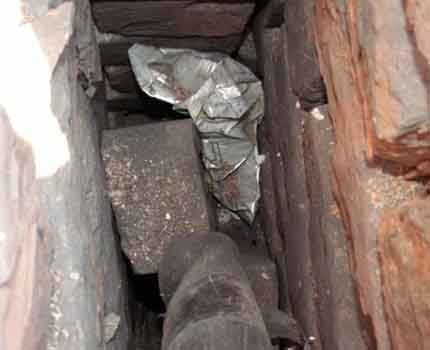
Preparatory work before carbon black removal
If cleaning starts from the chimney section located above the roof, safety must be taken into account. To do this, use a safety cable.
If there is none, then a rope is tied around the belt, the second end of which is fixed around a reliable support - a chimney pipe or a tree growing on the side opposite to the placement of the chimney.
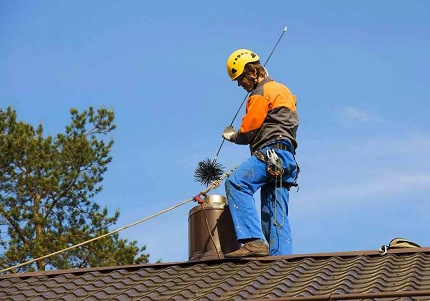
In order to minimize the ingress of soot into the house, and then it will be quite difficult to clean it later, the doors of the firebox and the black wire are tightly closed. The fireplace is hung with a damp cloth.

Cleaning sequence
Before starting work, it is necessary to find out how you can clean the chimney from the bottom without getting out on the roof. And only if this is not possible, they start cleaning. Start with a section of pipe protruding above the roof, previously removing spark arrester and / or deflector.
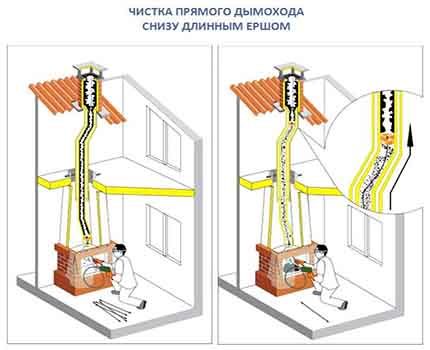
If cleaning starts from the roof, then the work is carried out in the following order:
- Having folded all the devices in a bucket, they rise to the roof, fix the safety cable.
- Remove the fungus or deflector, if any, from the head of the pipe.
- They clean the smoke channel, trying to remove all deposits - holding the cable, lower and raise the ruff with a weight.
- After the channel is cleaned, put the tools in a bucket, install the deflector in place. Having unfastened the safety cable, they go down.
- In the house or in the attic, clean-up doors (carbon blacks) are opened and soot soot is removed.
Continuing to move from the upper channels to the lower ones, they carry out cleaning, after which the sprinkled soot is selected and the doors are closed.
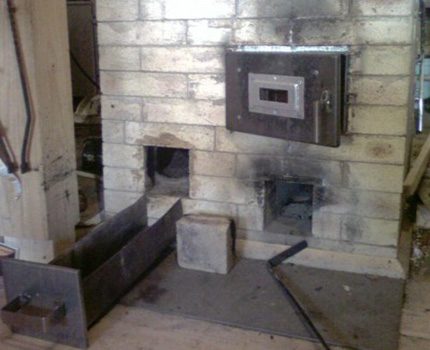
All cleaning operations are carried out carefully. A newspaper, oilcloth or thick cloth is covered on the floor. Soot that has fallen to the floor is first collected with a vacuum cleaner or with a dry broom, a rag. After everything is collected, wash the surface.
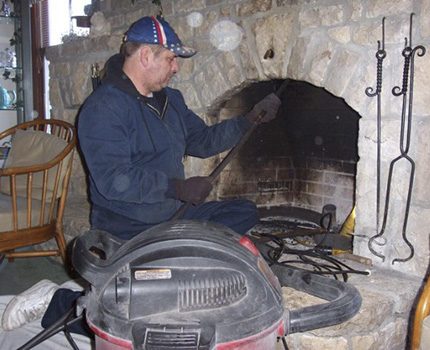
It is better to choose a vacuum cleaner with a plastic container, or use industrial electrical equipment - it is easier to clean them from pollution. There are also models specifically designed to collect soot and ash.
How to make a ruff with your own hands?
In order not to buy a ruff, you can make your own device for cleaning the chimney from plastic bottles or a metal cable.
Plastic is more versatile and suitable for all types of chimneys. Whereas with a metal brush you can damage the protective coating of chimneys made of galvanized steel or tear off the clay layer, which is applied to give smoothness to the internal surfaces.
To make a ruff from a plastic bottle, you need a steel cable with a diameter of about 2 mm, a clamp, two plastic one and a half liter bottles. The bottles are cut in half (across), dissolve into strips, leaving the upper part intact.
Holes of small diameter are made in the bottoms using a hot metal object (wire, screwdriver). The same hole is made in the covers.
The halves are connected to each other, putting on a threaded hook in the following sequence: bottom, neck with cover, neck with cover, bottom. Fix the connection with two nuts and two washers.
Then, a connector is put on the end of the hook and a threaded rod (rod) of the corresponding diameter is screwed onto it. You can also use a plumbing cable to clean sewer pipes. The cable length can be about 2 m.
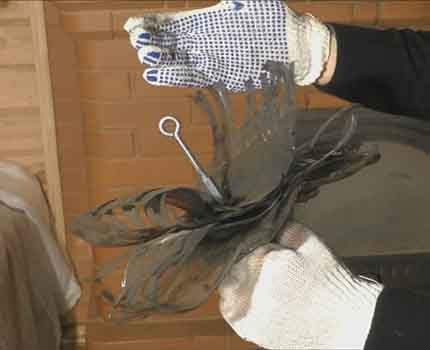
To clean the blockage in the chimney, you can use a ruff fixed on a cable to which a heavy object is attached from below. As a weighting agent, a metal ball can be used. Objects with a displaced center of gravity are not recommended to be used, since they can turn over and get stuck in the chimney.
Chemical cleaning
Effectively prevent the accumulation of soot in the chimney will help special means. They are intended for prevention and are designed to ensure that their use is regular.
These additives are used during the combustion of firewood. As a result, soot is destroyed at the burning stage. They are used before you clean the chimney mechanically, as well as periodically, throughout the heating season.
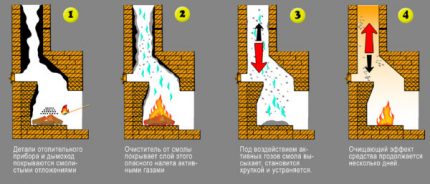
Use of powder products
Powder chemical cleaner is designed to burn deposits formed on the walls of smoke channels, furnaces. The product is burned with solid fuels and prevents the deposition of soot and tar.
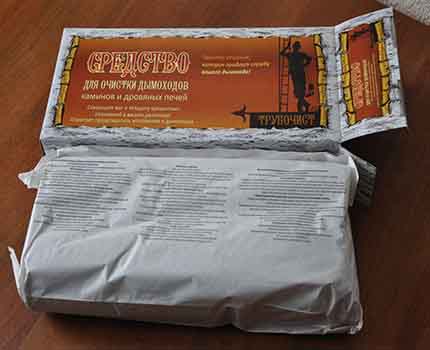
The use of a catalyst allows partial burning of soft deposits and loosening of hard plaque. The systematic use of the tool allows you to maintain the efficiency of the use of heating systems and stove devices.
The rate of addition of powder is approximately 1-2 kg per ton of fuel or 1-2 tablespoons for every 10 kg. When using firewood from resinous tree species, a catalyst is used every third load. A catalyst that is used correctly should produce a yellowish white smoke.

Chimney cleaning with log chimney sweep
One of the effective means of combating creosote deposits is a special log. This is absolutely non-toxic, which can be used to clean stoves, fireplaces, boilers, working on wood, coal.
To use logs “Chimney sweep” very simple. To do this, it must be set on fire and left to burn. As it burns, smoke enriched with salt mineral penetrates creosote, dries and makes it loose. Thus, it is possible to almost completely clear the walls of the channels from deposits.
Folk remedies for soot accumulation
The most famous antiquated way to deal with clogging in chimneys is the burning of potato peelings. Their use is most effective during intense burning.
Under the influence of high temperature, steam is formed with a high starch content, which loosens and softens deposits. Soot exfoliates and crumbles. Such a method is suitable for the prevention of obstruction of channels and as preparation for mechanical cleaning.
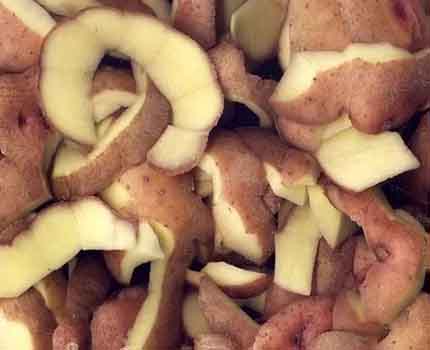
Burning aspen wood in large quantities, as a method of cleaning soot from the chimney, although it is considered effective, can lead to bad consequences.
High temperatures, which lead to soot ignition in the chimney ducts, can cause a fire if it has cracks or damage. In addition, not all metal sandwich chimneys can be operated at very high temperatures.
How to reduce chimney fouling?
It is common for different types of heating devices to accumulate soot in smoke ducts at different speeds. So, the more protrusions, roughnesses and irregularities, the more soot settles on the walls. Prevents soot from entering the atmosphere and numerous turns or improperly laid out smoke channels.
But if the stove, fireplace, boiler is already installed, then there is no way to change its design. But you can minimize the remaining negative factors that lead to severe pollution of the chimney.
Optimum Fuel Selection
When any fuel is burned in the chimney, a deposit of soot and soot is formed. But one kind of it can form more deposits than the rest. You can reduce the intensity of pollution if you use the "right" fuel.
The wood of different tree species has a different chemical composition. Different contents of tar, oils, tar, creosote affect the degree of sedimentation on chimneys. The fewer of these substances in wood, the less soot will form during combustion. Other types of solid fuels also affect pollution to varying degrees.
What fuel forms soot more than others:
- coniferous wood - spruce, pine;
- birch firewood, in which there is a high tar content;
- briquettes and pellet granules from the husks of seeds due to the high oil content give intensive soot formation.
It must also be said that incineration of household waste, especially plastic, also contributes to plaque formation.
In contrast to these types of fuel, firewood from oak, hornbeam, beech, walnut, plane tree, pear, and apple tree can be noted. These hard rocks are much less polluting chimneys.
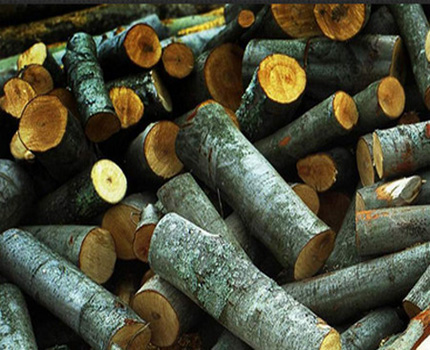
Burn well and leave a little soot sawdust briquettesotherwise referred to as Eurodroves. When burning, they do not spark, weakly absorb moisture, so they can be stored in kitchens near the stove.
Dependence on humidity and combustion temperature
It is highly advisable to use dry wood for heating rooms - the drier the better. The fact is that, when burning wet fuel, ashes under the influence of steam rises with it and sticks together into lumps. It becomes heavier and cannot leave the chimney. As a result, it accumulates inside the chimney in the form of soot.
Therefore, they need to be prepared in advance and stored under a canopy, in special covered rooms, sheds. Under such conditions, it will be possible to achieve 15–20% humidity. In this case, the degree of dryness will always fluctuate depending on the humidity in the room, on the street.

The amount of soot formation is also affected by the combustion temperature. The worse the wood burns, the greater the degree of pollution, the more often it will be necessary to produce chimney cleaning.
This is due to the fact that at low temperatures an excess of carbon particles is formed, which settles in the form of soot and soot. This phenomenon is especially characteristic for the initial burning, when firewood only flares up.
Therefore, when kindling a stove or fireplace, you need to strive to increase the temperature in the furnace as quickly as possible - to melt the stove with dry wood, use more thin and dry chips.
In addition, after the fire is extinguished, it is necessary to retain heat. To do this, as soon as all the fuel burns out in the stove, close the gate. And then at the next kindling the temperature inside the stove will be much higher than if it had not been closed.
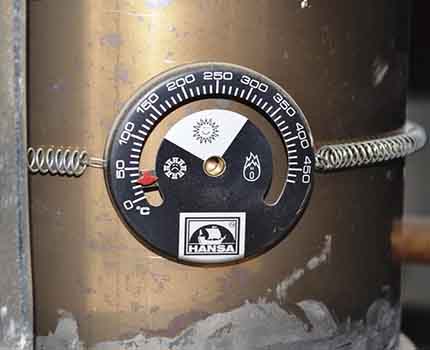
Conclusions and useful video on the topic
Video # 1. Use of chemicals:
Video # 2. Cleaning chimneys using potato peelings:
Video # 3. How to make a ruff from a plastic bottle and clean the chimney with it:
You can check how you managed to clean the chimney from soot with the help of a newspaper. They set it on fire and bring it to the firebox and to the clean doors.
If there is no draft in any section, then, most likely, in the channels located above, the blockage could not be eliminated. In this case, it is better to invite a chimney sweep, which will help to pinpoint the cause and cope with poor traction.
Tell us about how you cleaned the chimney in your own country house or in a country house. Please write comments in the block under the text of the article. Ask questions, share information useful to visitors to the site, leave photos on the topic.

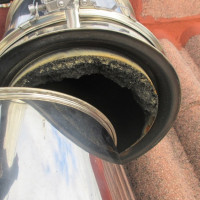 Chimney cleaning products: the best way to clean the chimney from soot
Chimney cleaning products: the best way to clean the chimney from soot  How to make a gate for a chimney with your own hands: instructions for making a valve
How to make a gate for a chimney with your own hands: instructions for making a valve 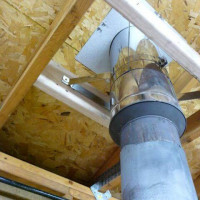 How to make the right chimney for a do-it-yourself stove: a step-by-step instruction
How to make the right chimney for a do-it-yourself stove: a step-by-step instruction 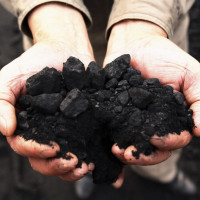 The calorific value of different types of fuel: a comparison of fuel by calorific value + table of calorific value
The calorific value of different types of fuel: a comparison of fuel by calorific value + table of calorific value  How is a ceramic chimney constructed: the specifics of installing a ceramic chimney
How is a ceramic chimney constructed: the specifics of installing a ceramic chimney 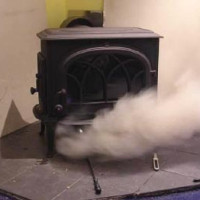 Why there is back draft in the chimney and how to correct the situation
Why there is back draft in the chimney and how to correct the situation  How much does it cost to connect gas to a private house: the price of organizing gas supply
How much does it cost to connect gas to a private house: the price of organizing gas supply  The best washing machines with dryer: model rating and customer tips
The best washing machines with dryer: model rating and customer tips  What is the color temperature of light and the nuances of choosing the temperature of the lamps to suit your needs
What is the color temperature of light and the nuances of choosing the temperature of the lamps to suit your needs  Replacement of a geyser in an apartment: replacement paperwork + basic norms and requirements
Replacement of a geyser in an apartment: replacement paperwork + basic norms and requirements
Cleaning chimneys and a fireplace is not the most pleasant thing, and not the cleanest one either. And still not very healthy! But at least once a year I have to deal with this. I clean the fireplace, stove and furnace in the bath. I tested almost all of the above methods, did not reach the vacuum cleaner only 🙂 But still, the most effective way to clean, in my opinion, is mechanical, brush, old-fashioned.
Hello. I note that with a conventional vacuum cleaner it is undesirable to clean soot. Need a specialized, fireplace. Normal will clog and 100% fail.
In our village house we are only in the summer, in late spring and early autumn. But we do not drown a solid Russian stove, even when it's cold, because we are afraid to burn the house because of a long uncleaned chimney. Aunt claims that the chimney could become clogged on its own even with the stove not working. Is that possible? Maybe the birds ever flew into the pipe above?
This is exactly where Russian stoves have a sore spot, if they are not heated for a long time. Anyway, if the furnace has not been used for a long time for its intended purpose, it must be carefully checked before being drowned so as not to burn.
Back to the Russian solid stove. There is such a tricky section in this design, which it calls a hog, it is located horizontally. Here it is actually necessary to check for the absence of cracks, if they are, then you need to cover up, and then heat the stove. The chimney can also become clogged if it is not heated for a long time, this can be bird nests, dust, and other rubbish.
After lighting, check the draft, adjust the flaps, although after a long period of inactivity the draft may be completely absent. And for the first time, do not heat the stove very actively, do not leave it unattended.